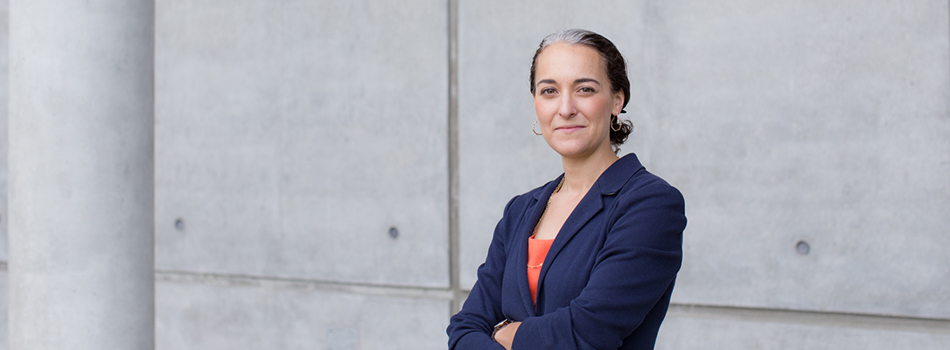
New book by Keramet Reiter chronicles the rise of modern solitary confinement.
In the 1980s, incarceration rates were skyrocketing and prison officials were anxious because of inmate unrest in the previous decade.
To house the prisoners – and to sequester those deemed most dangerous – prison officials designed and built with little public oversight a suite of technologically advanced maximum security prisons. The facilities were cleaner than the squalid, poorly-lit, unsanitary isolation cells that officials had been using to lock up prisoners accused of fomenting unrest and threatening security.
But conditions at these “supermax” isolation units – typified by 1,056-bed isolation ward at California’s Pelican Bay State Prison, which opened in 1989 – are still inhumane enough to drive some prisoners insane.
Keramet Reiter, an assistant professor of criminology, law and society at the School of Social Ecology, documents the rise of modern solitary confinement and the conditions inside in her recently published book, “23/7: Pelican Bay Prison and the Rise of Long-Term Solitary Confinement.” Reiter was recently awarded the American Society of Criminology's prestigious annual Ruth Cavan Young Scholar Award, which recognizes a criminology scholar who has received his or her degree in the past five years.
“I thought that if people knew what happened in solitary confinement, they’d be more critical of it,” Reiter says. “We have a sense as human beings of what it takes to have a semi-normal life and we have this visceral discomfort when we hear about isolation conditions that this isn’t it.”
Because California officials were reluctant to allow Reiter access to isolation units, she relied on dozens of interviews with prisoners who were out, plus information from senior prison officials who had designed isolation units. “A lot of the story of the book is trying to do research on a place that’s hidden,” Reiter says.
Cells are generally 8 feet by 10 feet and made of poured concrete, with ledges for a bed and a desk. A steel toilet and sink provide plumbing. Florescent lights are on 24 hours a day. Steel doors have only a slot for a food tray to slide in.
For an hour and a half a few days per week in California, prisoners are let into a small yard, usually called a dog run, that’s a bit bigger than the cell and has some natural light. There, they can pace.
Psychological conditions deteriorate quickly, and symptoms are similar to post-traumatic stress disorder. Anxiety. Heart palpitations. Hallucinations. Trouble sleeping. Aside from being cuffed to see a doctor or lawyer, prisoners can go years without human contact or shaking someone’s hand.
Post-release, prisoners have trouble in crowds and open spaces where there is no wall behind their backs. They also struggle with the lack of control over small, daily situations, such as the cleanliness of the cap on a shared toothpaste tube.
“We’ve been engaging in a mass experiment with this length of confinement and there’s not great data on how people recover,” Reiter says.
Reiter first grew interested in prison research when she was teaching in prisons in college in Boston. At the time, in the early 2000s, Massachusetts was looking at solitary confinement reform and Reiter did advocacy work for a few years.
She found little solid research on the history of solitary confinement policies, or how they affected prisoners. So she decided to go to grad school to study the more hidden aspects of incarceration, especially solitary confinement.
Prison officials built the maximum security prisons of the 1980s in response to violence and unrest in prisons in the 1970s. In particular, Reiter says, prison officials pointed to the story of George Jackson, an African American man who was incarcerated for armed robbery 1961, given an indeterminate sentence of one year to life, and repeatedly denied parole. He believed he’d never get out because of racism.
By the early 1970s, Jackson had become radicalized, and wrote about the need for a (potentially violent) restructuring of the system to eliminate prisons. He was accused killing a prison guard and pre-emptively sent to death row awaiting trial. He attempted to escape, and was shot and killed.
Nationwide, prison officials started clamping down, sending to isolation those prisoners they deemed most dangerous. But it’s often the prisoners who are difficult to manage that end up in isolation: mentally ill people, pregnant women and, especially, perceived gang members.
When Reiter started her research, California had more than 4,000 people in solitary confinement. In 2011, the state had 500 people – many of them labeled as gang members – who had been in continuous solitary confinement for more than 10 years.
“They had no real hope of getting out,” Reiter says. Legal restrictions require the justification be for safety and security. But that question of whether isolation increases security has hardly been studied, “which is shocking,” Reiter says.
In recent years, reforms have resulted in all but a handful of those prisoners in long-term isolation in California getting moved back into the general prison population. Across the country, states are enacting reforms, by lowering the number of prisoners in isolation, limiting the time spent there and making conditions more bearable by increasing natural light and adding nature videos for prisoners to watch.
“We’re paying attention right now and we’re working on getting some people out, but is this sustainable? Especially when we have this infrastructure, like Pelican Bay, sitting almost empty,” Reiter says. “What are we going to do with that building? Are there going to be more dangerous people that sort of percolate up and end up there?”
Hundreds of prisoners in California alone are being released from solitary confinement directly to city streets. And the mental and emotional impacts of solitary confinement are still poorly understood. “These are the kinds of things we should all want to know about,” Reiter says.